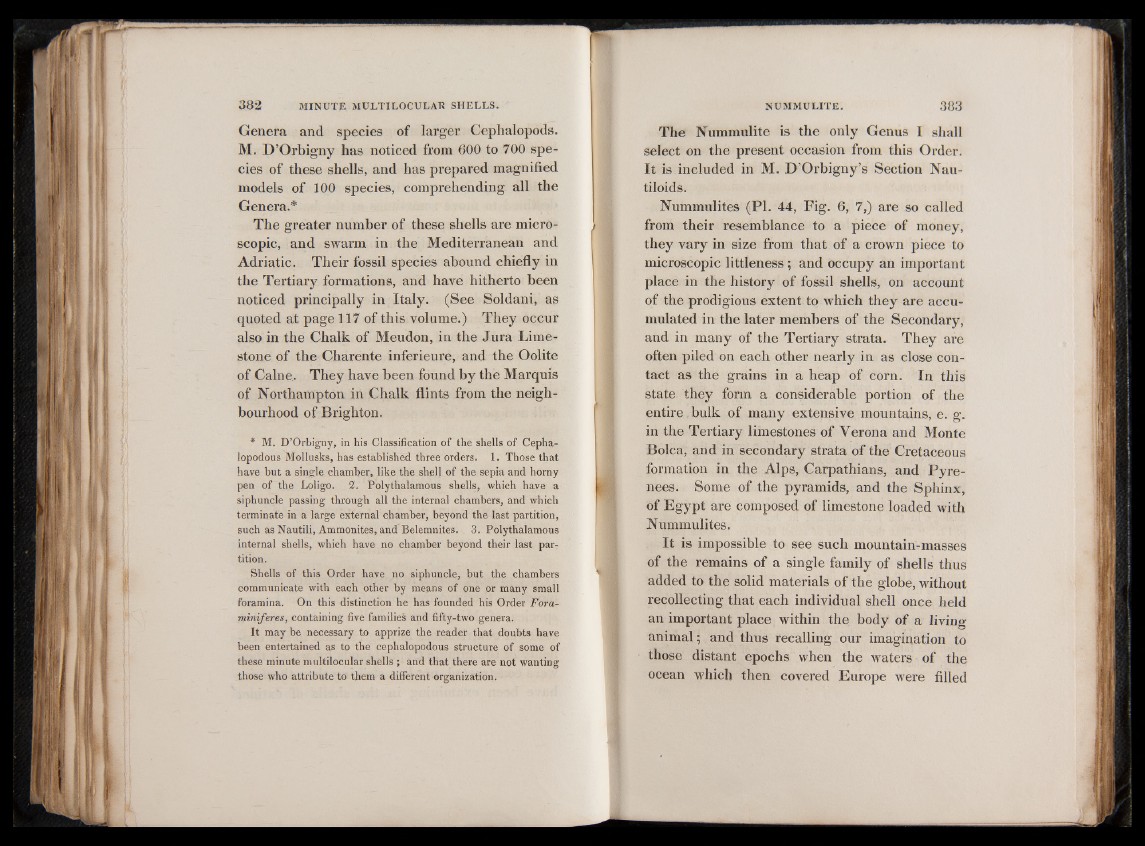
Genera and species of larger Cephalopods.
M. D ’Orbigny has noticed from 600 to 700 species
of these shells, and has prepared magnified
models of 100 species, comprehending all the
Genera.*
The greater number of these shells are microscopic,
and swarm in the Mediterranean and
Adriatic. Their fossil species abound chiefly in
the Tertiary formations, and have hitherto been
noticed principally in Italy. (See Soldani, as
quoted at page 117 of this volume.) They occur
also in the Chalk of Meudon, in the Jura Limestone
of the Charente inferieure, and the Oolite
of Caine. They have been found by the Marquis
of Northampton in Chalk flints from the neighbourhood
of Brighton.
* M. D’Orbigny, in his Classification of the shells of Cepha-
lopodous Mollusks, has established three orders. 1. Those that
have but a single chamber, like the shell of the sepia and horny
pen of the Loligo. 2. Polythalamous shells, which have a
siphuncle passing through all the internal chambers, and which
terminate in a large external chamber, beyond the last partition,
such as Nautili, Ammonites, and Belemnites. 3. Polythalamous
internal shells, which have no chamber beyond their last partition.
Shells of this Order have no siphuncle, but the chambers
communicate with each other by means of one or many small
foramina. On this distinction he has founded his Order Fora-
miniferes, containing five families and fifty-two genera.
It may be necessary to apprize the reader that doubts have
been entertained as to the cephalopodous structure of some of
these minute multilocular shells ; and that there are not wanting
those who attribute to them a different organization.
The Nummulite is the only Genus I shall
select on the present occasion from this Order.
It is included in M. D’Orbigny’s Section Nau-
tiloids.
Nummulites (PI. 44, Fig. 6, 7,) are so called
from their resemblance to a piece of money,
they vary in size from that of a crown piece to
microscopic littleness ; and occupy an important
place in the history of fossil shells, on account
of the prodigious extent.to which they are accumulated
in the later members of the Secondary,
and in many of the Tertiary strata. They are
often piled on each other nearly in as close contact
as the grains in a heap of corn. In this
state they form a considerable portion of the
entire bulk of many extensive mountains, e. g.
in the Tertiary limestones of Verona and Monte
Bolca, and in secondary strata of the Cretaceous
formation in the Alps, Carpathians, and Pyrenees.
Some of the pyramids, and the Sphinx,
of Egypt are composed of limestone loaded with
Nummulites,
It is impossible to see such mountain-masses
of the remains of a single family of shells thus
added to the solid materials of the globe, without
recollecting that each individual shell once held
an important place within the body of a living
animal; and thus recalling our imagination to
those distant epochs when the waters of the
ocean which then covered Europe were filled